Dorsoventral vs. Septotemporal hippocampus
Everybody knows what the hippocampus is for: memory. And…maybe something about anxiety or depression? Yes – over the last 10 years or so many studies have been published showing that the hippocampus has these two roles and that the mnemonic and emotional functions of the hippocampus are associated with its septal (dorsal) and temporal (ventral) ends, respectively. This new knowledge means that we’ve had to reorient our perspective. What we see when we consider the septal hippocampus may not be the same if we only consider its temporal end. My goal here is not to provide a review of the memory vs. emotional functions of the hippocampus (btw this dichotomy is a vast oversimplification). Instead, I’d like to talk about how people have differentiated these two ends of the hippocampus in their analyses. I’m also happy to showcase a bunch of pretty anatomical images that will probably never be published in a traditional journal article.
Some studies showing different functions of septal and temporal hippocampus
- Some of the best reviews of the topic are by Bannerman et al from 2004 and 2011.
- A recent and free review article by Fanselow and Dong.
- Classic Moser papers showing spatial memory is more dependent on dorsal hippocampus and anxiety/fear behavior on ventral hippocampus
- A recent paper suggesting that spatial processing in the septal hippocampus meets the behavioral-control functions of the temporal hippocampus to enable rapid spatial learning
History of neurogenesis quantification. So, back in the day, before I even knew what a neuron was, and before it was well-established that there was functional differentiation along the hippocampal axis, people would pick a few sections from the dorsal hippocampus (it’s much more photogenic, gets all the glory), count new neurons, and make it a density measurement. Then the stereology police arrived (seriously, that’s what they’re called) and pointed out that changes in tissue volume or cell packing could change density measurements without there being any differences in numbers of cells. Stereological analyses also prevent any biases that might arise from creating arbitrary boundaries when examining only part of the hippocampus. And so people started doing stereological counts, which require a systematic quantification throughout the entire hippocampus. My guess is that this probably delayed the appreciation that neurogenesis could vary in magnitude and function along the hippocampal axis. Now that we know that stereology is pointless we can get back to business (this is a joke – please don’t arrest me).
Difficulty of quantifying subregions due to curvature of the hippocampus. One of the reasons the hippocampus is such a popular neurobiological model is its anatomy – the dentate gyrus, CA3 and CA1 subfields are all composed of tightly packed cells that are easy to identify. Thinking of the hippocampus along its long axis, one end projects to the septum and the other abuts the temporal lobe, hence “septotemporal” is technically the most accurate way to refer to the different ends of the hippocamus. The hippocampus is curved in such a way that you can actually cut it along any of the 3 spatial planes (X, Y, Z aka coronal, horizontal, sagittal) and hit the hippocampus perpendicular to the septotemporal axis somewhere, giving rise to the classic the trisynaptic circuit. However, because of this same curvature, sectioning the brain in only one of the three planes means that some portion of the hippocampus is not going to be cut perpendicular to the long axis, producing sections in which septotemporal coordinates are hard to define.
The 3D nature of the hippocampus using images from the Allen Brain Explorer:
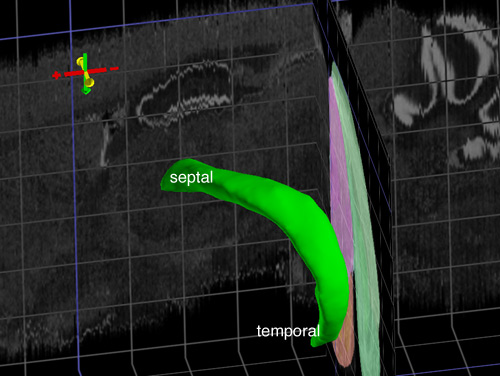
Figure 1: The dentate gyrus subfield of the hippocampus (i.e. green banana), from its septal pole, extends caudally and laterally and then ventrally. Green axis=dorsoventral, red=rostrocaudal, yellow=mediolateral.
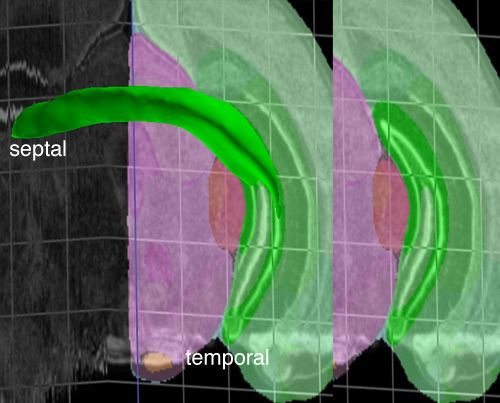
Figure 2: A relatively caudal coronal section with the 3D dentate gyrus shown in the left panel, for comparison. This section contains ventral dentate gyrus (at the bottom, by “temporal”) but, at the top of the section, it also contains a portion of the dentate gyrus that is very dorsal, despite being far from the septal pole.
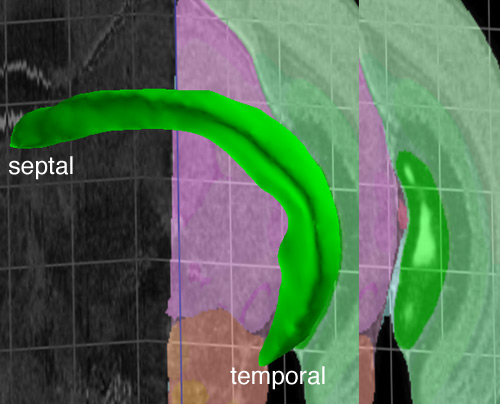
Figure 3: This section is more caudal than the previous example, yet the dentate granule cells (white patches within the bright green region) do not extend as far in the ventral direction. So, more caudal ≠ more ventral.
Others on the curvature problem:
Schlessinger et al., 1975: Since the dentate gyrus follows the general curvature of the hippocampal formation, it is difficult to apply the usual topographical terms to its various parts. The rostral third or half of the gyrus is more-or-less horizontally disposed within the cerebral hemisphere…At about the junction of its rostral and caudal halves the gyrus is sharply flexed upon itself, and comes to be vertically disposed….Again, because of the flexure of the hippocampal formation, it is inappropriate to refer to the dentate gyrus as having a dorsal (or rostral) and a ventral (or caudal) part. Following Gottlieb and Cowan (’73) we shall refer to the long axis of the gyrus, extending from the temporal pole of the hemisphere to just behind the septal region, as its temporalseptal axis.
Amaral & Witter, 1989: Because of its complex three-dimensional shape, normal sections of the hippocampus, i.e. those oriented perpendicular to the long axis, are obtained for only a small part of its septotemporal extent in standard coronal or horizontal sections. This situation severely complicates the analysis of the connections within the hippocampal formation.
De Hoz et al., 2003: In discussing different regions of the hippocampus, we use the terms “septal” and “temporal” to refer to the rostralmost and the ventralmost poles of the longitudinal axis, respectively, because this terminology allows an even division of this axis into septal and temporal halves. The terms “dorsal” and “ventral” are sometimes used to refer to the same areas; the dorsal hippocampus is, however, more extensive than the ventral.
So how can we divide the hippocampus? Many people work with coronal sections. Can we delineate boundaries between different hippocampal subregions in coronal sections? Banasr et al. has described a reproducible method for separating dorsal from ventral hippocampus using coronal sections. Here, the dorsal regions would contain a fair bit of mid-septotemporal hippocampus but indeed, only the dorsal sections would contain septal hippocampus and only ventral sections would contain temporal hippocampus:
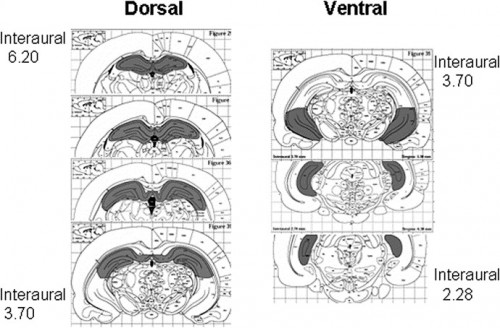
Figure 4: Separating dorsal and ventral hippocampus in coronal sections
Jayatissa et al. has horizontally sectioned the rat brain and then used anatomical coordinates to divide dorsal from ventral. This seems to be a good way to isolate pure, septal hippocampus but dorsal measures would again blur together the septal and mid-septal regions.
What if we wanted to separate the septal and temporal ends of the hippocampus? One method, described in Amaral & Witter, 1989 offers a solution:
We have adopted a strategy first described by Gaarskjaer that obviates this problem. In short…the fixed hippocampal formation is dissected from the brain and gently extended before histological processing. In this way the extended hippocampus can be positioned such that normal sections are obtained from much of the septotemporal extent of the structure.
I have used a similar approach (see here and here). One drawback is that you ruin much of the rest of the brain during the dissection process (insert but-who-cares-about-the-rest-of-the-brain joke here). Here’s a figure from my thesis that illustrates the similar-shaped hippocampal slices obtained with this method:

Figure 5: DAPI counterstained sections, evenly spaced across the septotemporal axis. Sampling scheme illustrated at the top. Shaded regions indicate how different septotemporal regions could be binned. S=suprapyramidal blade of the dentate gyrus, I=infrapyramidal blade, DG=dentate gyrus. Click on image to view high resolution version.
Another strategy, which I am currently exploring since I’m working with coronally-sectioned brains, isn’t too different from the method of Banasr, above. To get at the septal hippocampus I’m just being a bit more selective and only examining portions of the dorsal hippocampus that extend quite far rostrally. For the caudal sections that contain both dorsal and ventral hippocampus the rhinal fissure seems like a good guide – anything falling on the ventral side I’m counting as ventral [Update: this work has now been published; we found that new neurons mature more slowly in the temporal dentate gyrus, see the details here].
But if you’re lazy…
A fast, revolutionary new method for examining the hippocampus along its full septotemporal axis in a single section! It almost sounds too good to be true. In fact, it is. But it provides some interesting pictures for those of you who have stuck with me this far.
Recently, we irradiated a lot of rats to eliminate adult neurogenesis. Before coming to any conclusions about the behavioral data we needed to know whether neurogenesis was completely blocked AND whether it was blocked throughout the entire dentate gyrus. We were too lazy to cut hundreds of sections for each rat so what we did was extract the hippocampus but instead of sectioning perpendicular to its septotemporal axis, we sectioned it parallel to, or along, its septotemporal axis by flattening and freezing it on a microtome stage. With this approach we could cut the entire dentate gyrus in about 30 sections and get sections that had the entire septotemporal length of the dentate gyrus present. We then stained them for NeuN and DCX to visualize neurons and immature neurons, respectively. I think every other section was stained; one example is shown below.
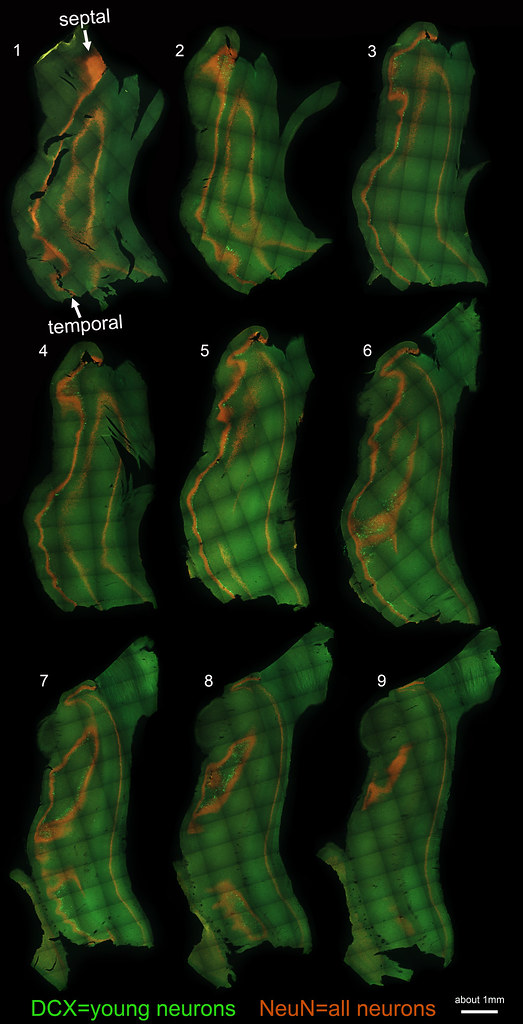
Figure 6: Hippocampal sections stained for NeuN and DCX. The dentate gyrus can be identified as the layer of tightly-packed orange cells on the left, that are bordered by green DCX+ cells. Sections were cut from the side of the infrapyramidal blade towards the suprapyramidal blade (direction of cutting = section 1→9). Images were taken with a 20x objective and subsequently stitched together. Click on the image to view the high resolution version. Even higher resolution images of the individual sections can be viewed on Flickr.
Is it really necessary to divide septotemporally? I guess it depends. Many studies that have focussed more on dorsal vs. ventral have made significant findings. If the anatomical method is well-described and reproducible, what more could you ask for? It’s possible, however, that combining different septotemporal regions into the same analysis could obscure a result. For example, when I examined activation of new neurons after water maze training I found a steadily-increasing amount of activation as I went from septal to temporal (see Figure 7). Had I pooled the 2 septal quartiles together and pooled the 2 temporal quartiles together the observed difference would have been much smaller than when comparing the septalmost quartile with the temporalmost quartile.
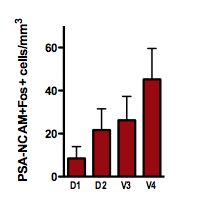
Figure 7: The density of ‘activated’ new neurons (i.e. PSA-NCAM+ and Fos+) increased from septal to temporal. Note the mid-septal and mid-temporal regions were similar. Also note that I used D and V nomenclature, for ‘dorsal’ and ‘ventral’, despite repeatedly emphasizing in this post that ‘septal’ and ‘temporal’ is more accurate. A reviewer told me to do this (and I listened).
——————————————————————————-
and now…
Pretty pictures from these sections!
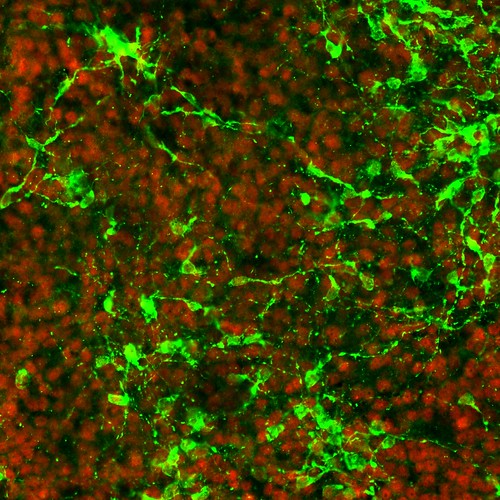
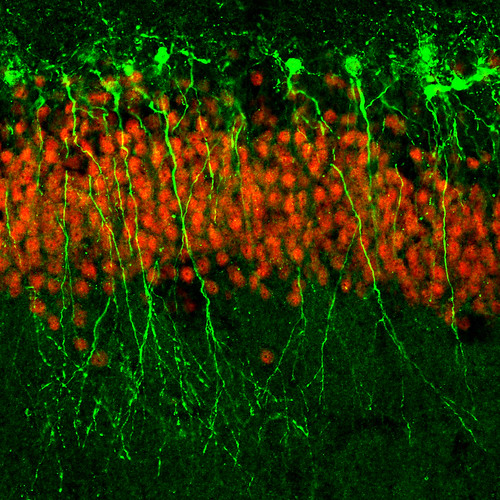
Just a nice example of some DCX dendrites.
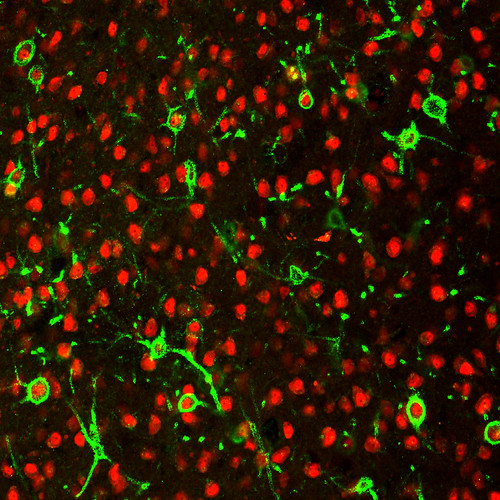
DCX labeling outside of the dentate gyrus. I think this was in the subiculum but who can say for sure with these weird sections.
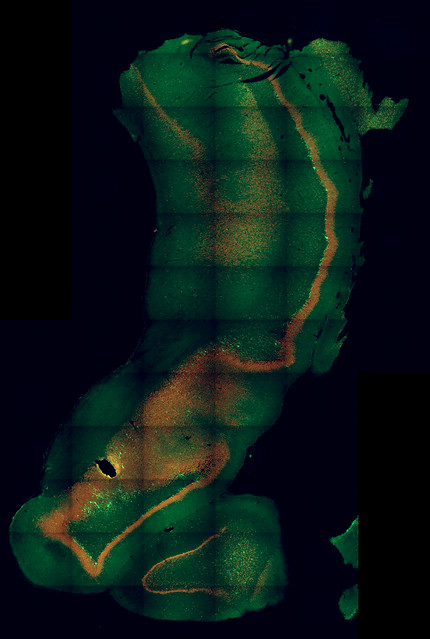
Septotemporal sample #1. Click on image to view high resolution version that may make your browser slow to a crawl (but which afficianados may think looks cool).
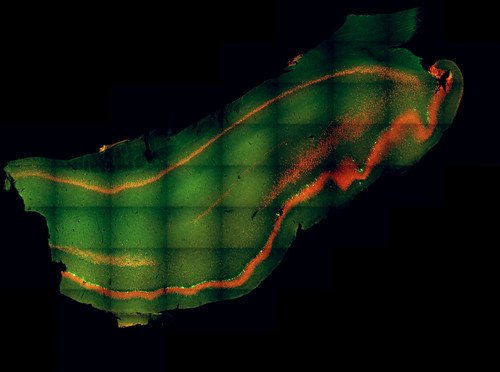
Septotemporal sample #2
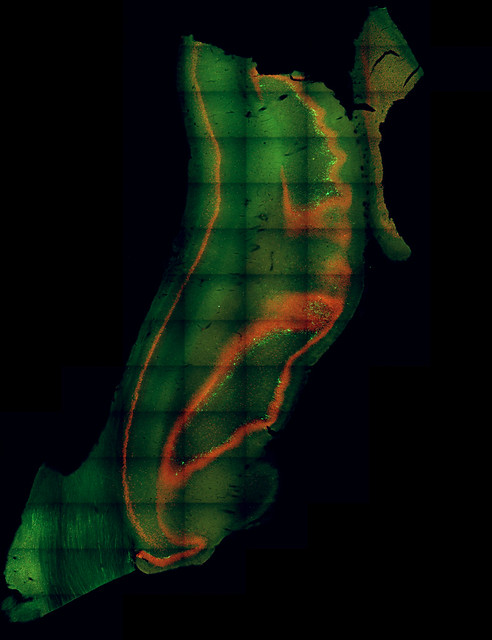
Septotemporal sample #3

Septotemporal sample #4

CRAB
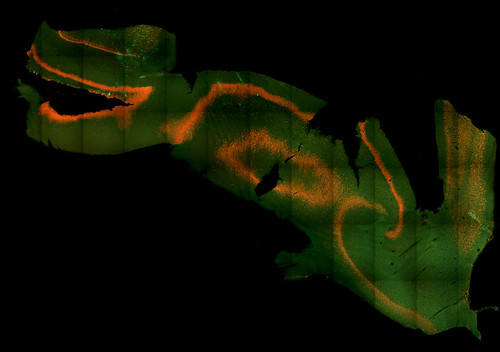
ALLIGATOR
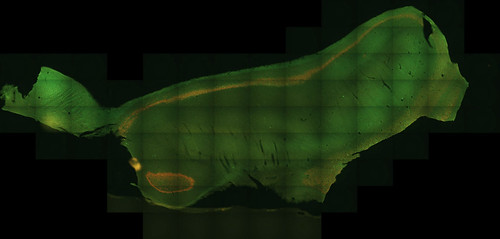
PUPPY / BIRDIE
Thanks and credit to Sarah Ferrante for sectioning, staining and imaging the tissue.

















My browser can handle it. Very nice work! Navigating those weird sections would be difficult but seems like a great way to delineate the two areas.
The hardest part was having the patience as my whole computer crawled and stalled as photoshop processed the enormous jpegs. The largest ones had to be reduced by 20% because Flickr wouldn’t accept them.
Hello.. I still wonder how was that you sectioned the brain.. could you draw it ?
I had to open them in GIMP rather than my browser(s) but it was worth it. I appreciate the review articles which aren’t behind paywalls.
Pingback: Our new paper: new neurons mature slower in the temporal/ventral dentate gyrus | Functional Neurogenesis